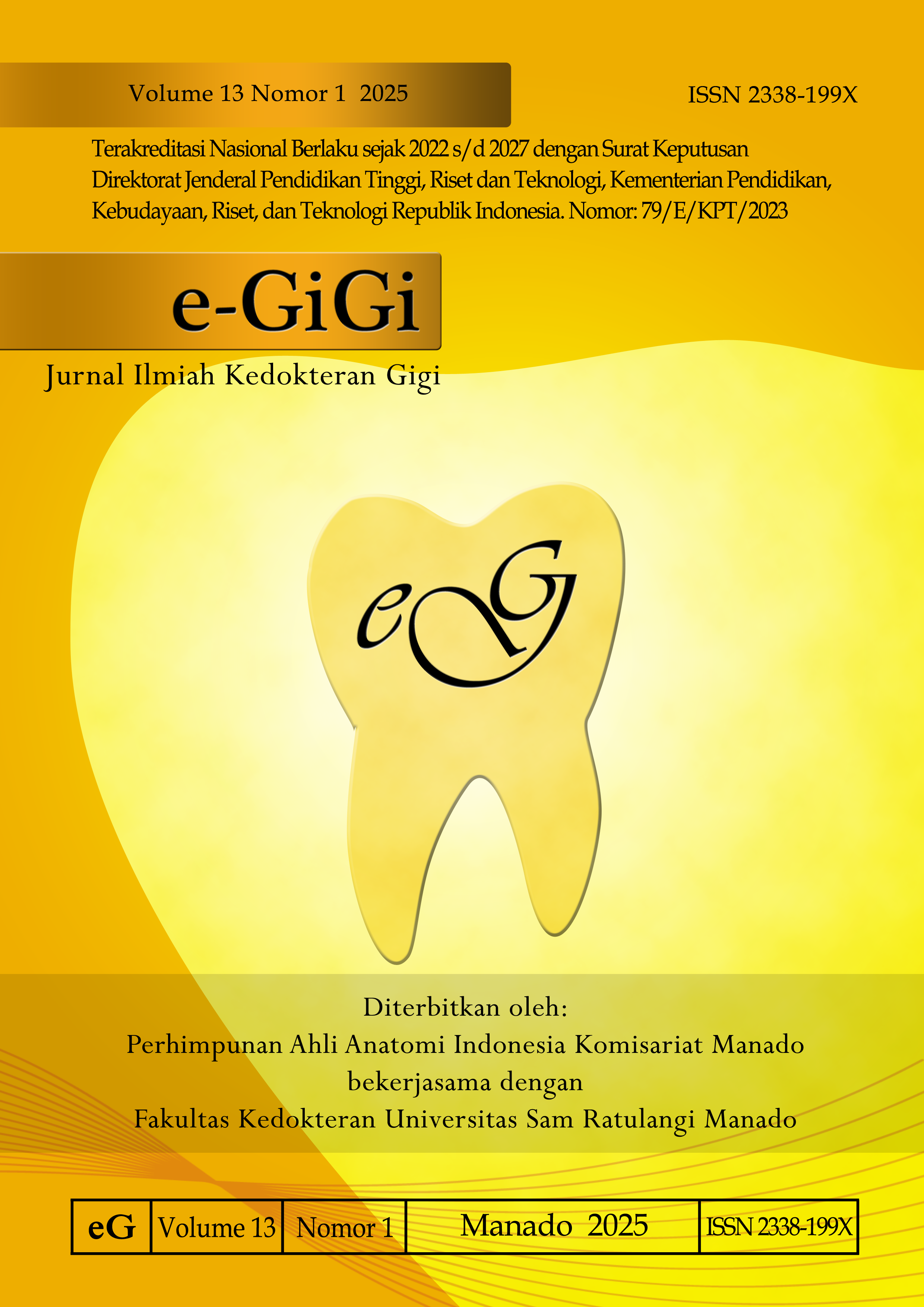Pengaruh Ekstrak Buah Rimbang (Solanum torvum Sw.) Terhadap Pertumbuhan Bakteri Enterococcus faecalis
DOI:
https://doi.org/10.35790/eg.v13i1.54028Abstract
Abstract: Root canal treatment is performed to eliminate causal factors of infection and remove necrotic tissue. However, during treatment, the persistence of the microorganism, Enterococcus faecalis, proved to be the cause of treatment failure. Currently a lot of research is being done on natural materials as an alternative to irrigation materials because they are considered to be more biocompatible and economical; one of which is the Turkey berry fruit plant (Solanum torvum Sw.). This study aimed to evaluate the effects of several concentrations of Turkey berry fruit extract on the growth of Enterococcus faecalis through minimum inhibitory and minimum lethal concentrations (MIC and LCmin). This was a post test only control group design study. Samples were divided into treatment and control groups: 12,5%, 25%, 50% dan 100% extract of Turkey berry fruit, chlorhexidine as the positive control, and 0.9% NaCl as the negative control. All of them had been implanted with bacterial suspension, and then were spread on the MHA media. Observations were performed after 24 hours of incubation, and bacterial colony were count manually. Data were analyzed using the non parametric Kruskal-Wallis test and the Tamhane’s post hoc test that showed significant difference among the groups with MIC at 25% and LCmin at 50%. In conclusion, Turkey berry fruit extract of 25% and 50% can inhibit the growth of Enterococcus faecalis.
Keywords: root canal treatment; chlorhexidine; Enterococcus faecalis; Turkey berry fruit
Abstrak: Perawatan saluran akar dilakukan untuk mengeliminasi faktor penyebab infeksi dan menghilangkan jaringan nekrotik. Persistensi mikroorganisme yaitu Enterococcus faecalis terbukti menjadi penyebab kegagalan perawatan. Saat ini banyak penelitian dilakukan terhadap bahan alami sebagai alternatif bahan irigasi karena dinilai lebih biokompatibel dan ekonomis, salah satunya tanaman buah rimbang (Solanum torvum Sw.). Penelitian ini bertujuan untuk mengetahui pengaruh tingkat konsentrasi ekstrak buah rimbang (Solanum torvum Sw.) terhadap pertumbuhan bakteri Enterococcus faecalis melalui pengamatan nilai konsentrasi hambat minimal (KHM) dan konsentrasi bunuh minimal (KBM) dengan menggunakan post test only control group design. Sampel penelitian dibagi atas kelompok perlakuan dan kontrol, yaitu ekstrak buah rimbang konsentrasi 12,5%, 25%, 50% dan 100% serta kontrol negatif dan positif yang telah ditanamkan suspensi bakteri disebarkan pada media MHA. Pengamatan dilakukan setelah inkubasi selama 24 jam dan perhitungan koloni bakteri secara manual. Data dianalisis menggunakan uji non parametrik Kruskal-Wallis dan uji Tamhane Post Hoc yang menunjukkan perbedaan bermakna antar kelompok dengan KHM pada konsentrasi 25% dan KBM pada konsentrasi 50%. Simpulan penelitian ini ialah ekstrak buah rimbang pada konsentrasi 25% dan 50% dapat menghambat pertumbuhan Enterococcus faecalis.
Kata kunci: perawatan saluran akar; chlorhexidine; Enterococcus faecalis; buah rimbang
References
Kartinawanti AT, Khoiruza Asy’ari A. Penyakit pulpa dan perawatan saluran akar satu kali kunjungan: literature review. Jurnal Ilmu Kedokteran Gigi. 2021;4(2):64-72. Doi: 10.23917/jikg.v4i2.15872
Garg N, Garg A. Textbook of Endodontics (4th ed). Jaypee Brothers Medical Publishers (P) Ltd; 2019.
Djuanda R, Aulia Helmika V, Christabella F, Pranata N, Sugiaman VK. Potensi herbal antibakteri cuka sari apel terhadap Enterococcus faecalis sebagai bahan irigasi saluran akar. Sound of Dentistry. 2019; 4(2):24-40. Doi: https://doi.org/10.28932/sod.v4i2.2141
Noviyandri PR, Andayani R, Ervina R. Potensi ekstrak alga merah Gracilaria verrucosa sebagai penghambat perkembangan pembentukan biofilm Enterococcus faecalis pada infeksi saluran akar gigi. Journal of Syiah Kuala Dentistry Society. 2018;3(1):6-15. Available from: https:// jurnal.usk.ac.id/JDS/article/view/11054
Nuriana N, Yusro F, Mariani Y. Sifat antibakteri Enterococcus faecalis ekstrak kulit kayu mangga pelam (Mangifera laurina Blum.) Jurnal Tengkawang. 2019;9(2):92-103. Doi: http://dx.doi.org/ 10.26418/jt.v9i2.36420
Fitriarti FA, Hadriyanto W, Nugraheni T. Pengaruh klorheksidin sebagai bahan irigasi saluran akar terhadap iritasi jaringan periodontal [Skripsi]. Yogyakarta: Universitas Gajah Mada; 2017.
Bilqis NM, Erlita I, Putri DKT. Daya hambat ekstrak bawang Dayak (Eleutherine palmifolia (L.) Merr.) terhadap pertumbuhan bakteri Lactobacillus acidophilus. Dentin Jurnal Kedokteran Gigi. 2018; 2(1):26-31. Doi: https://doi.org/10.20527/dentin.v2i1.405
Roststein I, Ingle JI. Ingle’s Endodontics 7. Raleigh, North Carolina: PMPH USA, Ltd; 2019.
Koomson DA, Kwakye BD, Darkwah WK, Odum B, Asante M, Aidoo G. Phytochemical constituents, total saponins, alkaloids, flavonoids and vitamin C contents of ethanol extracts of five Solanum torvum fruits. Pharmacognosy Journal. 2018;10(5):946-50. Doi:10.5530/pj.2018.5.160
Salsabila AN. Efek antibakteri ekstrak etanol buah rimbang (Solanum Torvum Sw.) sebagai alternatif bahan irigasi saluran akar terhadap pertumbuhan Porphyromonas Gingivalis (in vitro) [Skripsi]. Medan: Universitas Sumatera Utara; 2021.
Dewi ASA. Perbandingan daya antibakteri asap cair dan cresophene terhadap viabilitas Enterococcus faecalis secara in vitro [Skripsi]. Semarang: Universitas Diponegoro; 2022.
Anastasia MK. Uji efektivitas ekstrak etanol kulit pisang kepok kuning terhadap Enterococcus faecalis secara in vitro. [Skripsi]. Malang: Universitas Brawijaya; 2019.
Chaniago AE. Potensi antibakteri ekstrak buah okra (Abelmoschus esculentus) terhadap pertumbuhan Enterococcus faecalis ATCC®29212™ (in vitro) [Skripsi]. Medan: Universitas Sumatera Utara; 2021.
Churrillaily M. Efektivitas antibakteri ekstrak etanol siwak (Salvadora Persica) dalam membunuh bakteri Enterococcus faecalis. [Karya Tulis Ilmiah]. Medan: Universitas Sumatera Utara; 2023.
Rusida L. Efek antibakteri ekstrak etanol buah rimbang (Solanum torvum Sw.) sebagai alternatif bahan irigasi saluran akar terhadap pertumbuhan Fusobacterium nucleatum (in vitro) [Skripsi]. Medan: Universitas Sumatera Utara; 2021.
Downloads
Published
How to Cite
Issue
Section
License
Copyright (c) 2024 Putu R. K. Giri, IGA Fienna N. Sidiartha, Putri Rejeki, Elimia L. Putri

This work is licensed under a Creative Commons Attribution-NonCommercial 4.0 International License.
COPYRIGHT
Authors who publish with this journal agree to the following terms:
Authors hold their copyright and grant this journal the privilege of first publication, with the work simultaneously licensed under a Creative Commons Attribution License that permits others to impart the work with an acknowledgment of the work's origin and initial publication by this journal.
Authors can enter into separate or additional contractual arrangements for the non-exclusive distribution of the journal's published version of the work (for example, post it to an institutional repository or publish it in a book), with an acknowledgment of its underlying publication in this journal.
Authors are permitted and encouraged to post their work online (for example, in institutional repositories or on their website) as it can lead to productive exchanges, as well as earlier and greater citation of the published work (See The Effect of Open Access).






